#Disney Television Animation Rides
Text
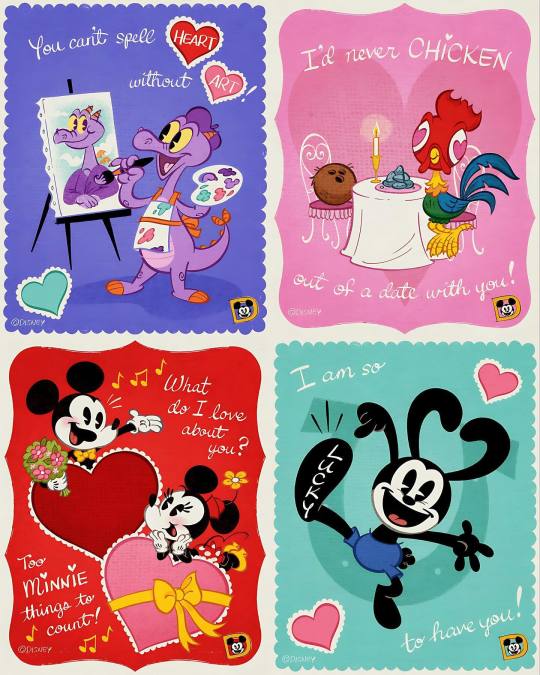

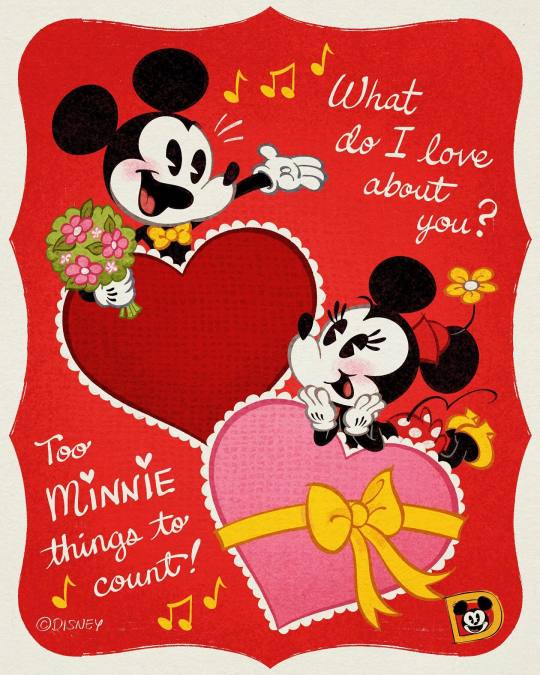
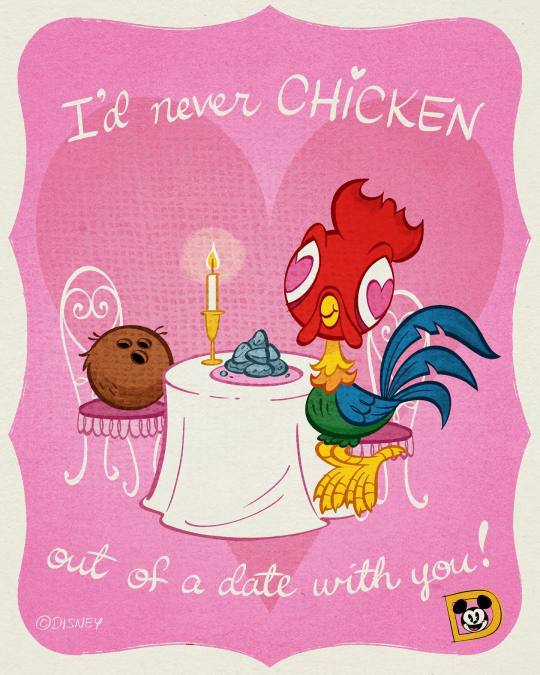
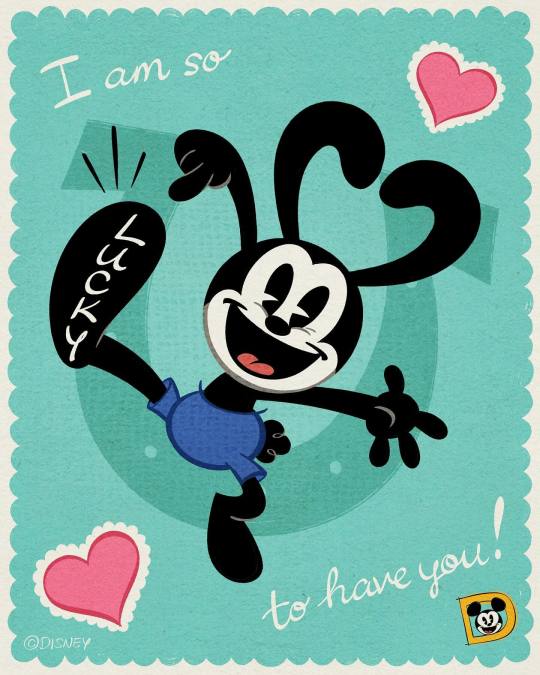
Love is in the air ❤️Spread what's left of Valentines Day with these aww-inducing cards by Disney TVA , Disney Yellow Two Shoes and Walt Disney Imagineering.
Desings by Asia Ellington ("The Wonderful World of Mickey Mouse" Franchise, "Primos").
#The Wonderful World of Mickey Mouse#Mickey Mouse Shorts#Mickey Mouse#Figment#Moana#Moana 2#Oswald The Lucky Rabbit#Asia Ellington#Paul Rudish#Disney Television Animation Rides#Disney TVA Rides#Disney Yellow Two Shoes#Walt Disney Imagineering#Seth Rogen#Point Grey Pictures#Matt Danner#Disney Digital Network#Jennifer Lee#Walt Disney Animation Studios
197 notes
·
View notes
Photo
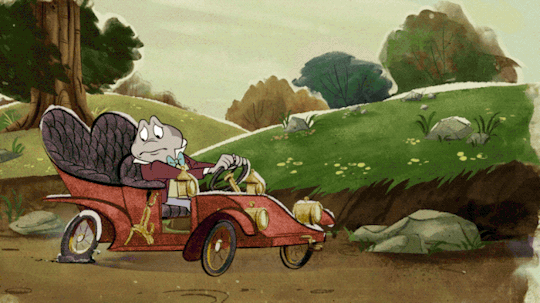
The Wonderful World of Mickey Mouse (2020), “Once Upon an Apple“
#my gif#The Wonderful World of Mickey Mouse#Once Upon an Apple#mr. toad#mr. toad's wild ride#animation#cartoons#gif#gifs#disney#disney gif#television#mickey mouse#car
168 notes
·
View notes
Text
anybaby wanna go to disney world with me?
imagine…
we wake up in our resort room just before sunrise. we cuddle in our blankets with our pacifiers and watch disney cartoons on the television as the sun comes up, then we get ready to have our adventure for the day!
we start by brushing our teeth with our favorite flavored toothpaste, put on plenty of sunscreen, then pick out our cutest, most magical outfits. you can choose to wear mickey ears or a princess tiara!
before anything else, though, we need to have breakfast. would you like mickey waffles or oatmeal? what flavor of juice should we get? eggs scrambled or fried? you pick!
after our meal, we pack up our disney-themed backpacks with sippy cups full of water (have to stay hydrated on an adventure!), autograph books, and other must-haves, and then it's time to set out! we head to the monorail and go on our way to magic kingdom.
the day is sunny and blue-skied when we arrive. we walk down main street, admiring cinderella's castle and stopping in stores! we each pick out a new plushie to come on our adventure with us. what would your dream disney stuffed animal be?
we ride plenty of baby-friendly rides and attractions — it's a small world, mad tea party, peter pan's flight, dumbo the flying elephant, the many adventures of winnie the pooh, prince charming's regal carousel, the jungle cruise, the journey of the little mermaid, the laugh floor from monster's inc, enchanted tales with belle, and of course, the walt disney world railroad train!
we meet some of our favorite characters along the way — we get plenty of hugs from them, our photos taken with them, and even get their autographs! what character would you most want to meet? we get to watch all the characters in a parade on main street, too, and we get a front row place to stand!
before we know it, it's time for lunch. we're skipping nap time, so we need something really delicious to keep us going... surprise! we have reservations to cinderella's royal table! how exciting is that?! we get to eat in the castle and meet all the princesses, too! we get special cups of juice with glowing buzz lightyear and tinkerbell straws.
after we finish lunch, we decide we're feeling extra brave, and want to go on a roller coaster like the seven dwarves mine train or space mountain. don't worry, we'll hold hands the whole time!
we have all sorts of fun the rest of the day and get plenty of souvenirs from the gift shops. we end the night with a special dessert-before-dinner as we watch the wishes fireworks together. would you like ice cream from the parlor or a pastry from the bakery?
when we get back to the resort, we're super tired. it was a long adventure for little ones, after all. but, we have a bubble bath and get all squeaky clean anyway, brush our teeth, and finish the night being told a disney bedtime story on the television cuddled up with our brand new plushies.
it was a magical day!
264 notes
·
View notes
Text
Tag Yourself as Aesthetics I resonate with

Changelingcore: Broken insect wings, wildflower meadows, catching tadpoles, lingering mist after it rains, wet shoes from the damp grass, the feeling of moss under your hands, collection of strange trinkets and objects, taking your stuffed animals on adventures, doodling on your clothes, busy hands, wading knee deep into a lake, screaming into the air to ease frustration, organizing and reorganizing your treasures, bird calls, animal howls, digging in the mud, chewing on your lip until it bleeds, bruises and scrapes, the urge to live in the woods and never return to regular society, knotted hair, forest shrines, putting flower blossoms in your hair, flooded swampy areas, jumping from short cliffs

Suburban Gothic: Hot muggy air sticking to your skin, the buzz of florescent lights, flickering street lights, budget popsicles, late night drug store visits, muffled arguments, an old clock ticking, guady wallpaper, gossamer curtains, dusty cotton sheets, faded quilts, dog barkings, milkshakes in an empty diner, broken windows and graffiti, abandoned train tracks, 24/7 laundromats, rusty swingsets, shadowy silhouettes, semi-abandoned malls, sounds of far off traffic and train horns, driving around at night while soft music plays on the radio, tv static, junk yards and pick-n-pulls, holding hands with a stranger, urban legends, varsity jackets, broken glass on the road, crumbling buildings, local television channels
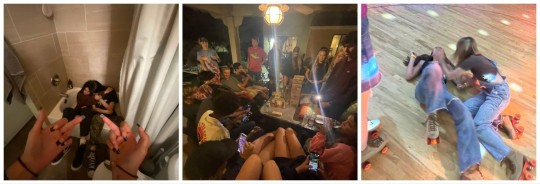
Cuddle Party: Excited giggles and hushed whispers, condensation on drinkware, running through an empty field hollering and whooping in the dead of night, sitting on the porch in rocking chairs, drunken "I love you"s, old cartoons, classic disney movies, five dollar pizza and breadsticks, singing out loud in the car, finding new places to explore, county fairs and arcade visits, eating fair food and screaming your lungs out on rides, trying to earn as many tickets at the arcade and still winning cheap prizes, being the last one to fall asleep, casually sleeping all together in the same bed, holding hands in crowds, if one of us isn't having a good time none of us are, wondering how long these days will last

Cryptid Academia: Listening to video essays while sketching cryptids, exploring abandoned buildings (legally and illegally), pocket knives, blackout curtains, newspaper clippings, viewing the night sky through a telescope, visiting natural history or science museums, old typewriters, info dumping conspiracy theories on friends, making plans to investigate that never come to fruition, tearing yet another hole into your clothes climbing over fences, shoddily patched up clothes, keychains and aluminum pins, novelty socks, analog watches, Buzzfeed Unsolved, cryptid podcasts, sprint training so you can outrun whatever is chasing you, rubiks cubes, sore fingers from mending, thrift shopping, essays only about cryptids

Desertwave: Billowing winds, sandstorms, wind chimes and suncatchers, succulents in handmade clay pots, aloe vera plants on the kitchen windowsill, the distant howl of a coyote, faded winnebagos, the soft hiss of patio misters, campsites and trailer parks, large rock formations covered in graffiti, picking up trash, the crackle of a bonfire, cacti and joshua trees in the backyard, never getting the sand completely out of your shoes, dusty clothes, laying in a hammock watching the stars, water balloon fights, hot springs, mexican ice cream bars, rocky desert mountains, plots of sand and plants that stretch on as far as the eye can see
#tag yourself#types of people#aesthetic#changelingcore#suburban gothic#desertwave#cuddle party#cryptid academia#mine#augies-posts
336 notes
·
View notes
Note
when does baby get into amusement parks??
(sorry for letting this ask languish but i wanted to save it as a post-study treat for myself) she gets into them when she's 7ish and checks out one of those promotional "a day at disneyland" dvd's from the library. its obviously mostly a prolonged commercial but it shows a ton of park footage and the hosts share lots of fun facts and there's a mini history lesson at the beginning about walt. baby LOVES this dvd and checks it out 1 million times and starts using some of her computer time to look up more facts about disneyland and eventually disney world and other theme parks. she doesnt really care about the properties much: she's just super fascinated by the way the parks are laid out like tiny cities and the elaborate theming and the ride engineering. sea world is of course fascinating to her and she spends like multiple months researching the dolphin/whale shows and solemnly pondering her stance on the ethics of keeping these animals captive. it's hard for her to get her hands on a lot of physical media about the more mechanical, dry aspects of theme parks when she's younger (this is a pre-defunctland world), so she does a lot of internet searching during her computer time and holds onto promotional material and merch from parks just to have Images of rides. jesse and demi can't directly feed this special interest the way they can her others (again, not a lot of non-youtube content out there for a while and alaska is pretty far away from the elaborate theme parks she's interested in), but they still listen intently when she shares her facts and let her have extra computer time for her "research" (baby loves research. so much.). one of demi's biggest wins as a parent is when she finds out about an entire episode of the educational program "popular mechanics for kids" (aka the greatest television show ever made) dedicated to roller coasters and briefly goes postal trying to find a dvd of it for baby. this becomes baby's favorite dvd in the world and even after she grows up and gets access to more theme park content as it becomes more popular, she still prefers this episode of pmk to all of it (demi: this is the best day of my life. jesse: yo is that kid the fucking dude who's in "knocked up"??)
#anonymous#ask#syd squeaks#anon this question was my carrot on a string for like this entire week thank u#baby ayuluk#demi ayuluk#jesse pinkman
7 notes
·
View notes
Text
A brief history of Shojo manga and anime [part 1]
Shojo is a demographic that its target audience is mainly girls and young women. It has grown many generations and continues to do so. Many believe that it’s not as interesting as Shonen, but actually Shojo has a rich history and background. In this article of two parts, a brief history of shojo is going to be examined; analysing the art, tropes, plots and evolution.
Post-War Shojo


In order to fully examine shojo manga, firstly it needs to be noted that for a few decades before the Second World War, shojo magazines appeared, slowly creating the aesthetic of the girlish teen culture, still maintaining the dreamy, flowery maiden-ish style.
In the 1950s the plots of shojo manga seemed to be limited on stories about elementary school girls, decreasing plots that older girls and young women would be interested in. Also, almost all the mangakas were men, so the storytelling was focusing on what men perceived the morals of female should be. Apart from that, a few iconic shojo manga made their debuts, including Osamu Tezuka’s “Princess Knight”, which set the ground for many action shojo afterwards and which is still influential today. It was also the first shojo manga that had an anime adaptation, with an art influenced from Disney. Nevertheless, the shojo manga art style was still indifferent from the rest of the demographics.
But the shojo art style had slowly started changing. Nakahara Jun’ichi was working in a girls’ magazine in the 40s and was the one who introduced the shojo-style eyes. Macoto Takahashi was the one who took inspiration from this style and started drawing it in his manga. By the late 1950s, sparkling eyes and three panels with an one-piece character on the side -characteristics that are integral in the shojo demographic-, were more and more standard. “Sakura Namiki”, by the same mangaka is one of his most known stories, where its art style seemed like a story book, but the characters and the decorations were very much shojo, though it goes back to pre-war Class S”, when there weren’t stories focused on female and male romantic relationships, and instead of that, they focused on relationships between girls, that usually remained spiritual and platonic. “Arashi O Kete” also by Macoto Takahashi is a good example of creating the dynamic presentation of shojo.
By the mid 1950s, many shojo magazines started forming and some of them focused exclusively on shojo stories. Kodancha, Shueisha and Ribon were the most popular.
60s


In the 1960s, a change is that from monthly, many shojo magazines switched to weekly, increasing the shojo stories. Magazines had also allowed readers to submit their manga for publications, thus many amateur artists became professional mangakas. By the mid and late 1960s, many young women made their debuts in the manga industry, slowly forming a circle of creating stories by women for women, something that was rare up until then. Shojo friend and Margaret were two shojo magazines that were formed back then.
Nishitani’s Yoshiko “Mary Lou” is a very important example, as it was the first shojo manga with the romantic comedy formula, featuring normal characters in a normal school. The win of women’s volleyball team in the Olympics, inspired Chikako Urano to write “Attack no. 1”, the first female sports shojo manga. Portraying girls in taking part in other more “masculine” sports in manga was new back then, as it was more standard for female characters to be portrayed performing ballet or horseback riding. It also became an anime television show.
Hideko Mizuno was the first to adapt ideas from American television movies and series, such as “Sabrina”, as “Sutekina Cora”, though previously there was a shojo anime series called “Sally the witch”, which was inspired from “Bewitched”. Other magical girls anime were “Himitsu no Akko-Chan”, where on contrary to Sally, who was a witch from the beginning, the heroine had magic accessories to transform, marking the start of the evolution of magical girls transformation.
In the late 1960s, serious issues started being more examined in shojo manga, as Yumiko’s Oshima Oshima “Tanjou” deals with an unwanted pregnancy of a teenage girl, dealing with the question of abortion. Hideko Mizuno’s manga “Fire!” is an interesting mention as it has a male lead as the main character, portraying the soul of the music in the late 1960s. It was also the first shojo manga that contained sex scenes. On contrary with the 1950s restraining portrayal of emotions, along with the 1960s more mature content in shojo manga, the panels were emotional-driven and the characters were portrayed with an outburst of emotions.
70s


During the late 1960s and early 1970s, the second wave of feminism started spreading and with this, combined with the readers who grew up to young women, demanding variety in plots, an emergence of more complex and graphic stories appeared. The storytelling had the tendency to be extremely melodramatic and romantic but with a dose of pessimism. Realism and logic was many times missing, and passion, emotions and feelings were pretty intense. It was also the start of sub plots. 70s Shojo manga is a beautiful, flowery, epic journey that is unforgettable. It’s pretty much the golden era of shojo, filled with many complex themes, more so than any other era after.
As it’s natural, shojo is a synonym for romance, so the romance genre was always present. Unlike the previous decades though, epic romances came and replaced the everyday life, simple stories. Period dramas especially, became very popular. Classics such as Ryoko Ikeda’s “The Rose Of Versailles”, which elegantly mixes facts and fiction of the French Revolution, Yumiko Igarashi’s ode to the orphan genre “Candy Candy” and Waki Yamato’s love letter to feminism and romance “Haikara-san ga Toru” are great examples of this. Each one of those also had their own television show. Those stories have in common the fact that their plots are as complex as their characters. They have the tendency to have many things going on simultaneously, with a cast of many characters and with strong female leads. In many ways they were inspired from classical literature, both international and Japanese. The mixture of 70s shojo tropes, such as tragical events, melodrama, over the top situations, along with inspiration from the classics, makes those stories an irresistible package of shojo. Being driven by emotions and drama, a variety of over the top portrayal of facial expressions and movements were very much presented.
The sports genre wasn’t missing from the shojo portfolio, as after Urano Chikako’s “Attack number #1”’s success, the following of other titles such as Sunika Yamamoto’s manga about tennis, “Aim for the ace” was pretty logical. Even though sports is a word that can describe only its area, ballet and acting can still fit this genre, as the physical determination of the heroines is pretty much the same (Ballet is a sport too though, but it contains acting too). So, Suzue Miuchi’s classical story about acting; “Glass Mask” and Kyoko Ariyoshi’s “Swan” are great examples of this. “Glass Mask” is still ongoing, marking the longest running shojo manga of all time. It also has several anime adaptations, from the passing decades, with many differences in aesthetic and technology. This legendary manga has its main focus in acting, different acting techniques and character grown. Its uniqueness also lies to the fact that there are many stories inside the story, as the reader gets to experience different plots from all the theatrical plays that are featured in the manga. This genre also emphasises on relationships that are not romantic, on contrary to most of shojo manga, as its main focus is rivalries and, team spirit and characters building a bond with each other or a mutual respect, through their same passion for their work.
There is a variety of stories in the sci-fi genre also, with Moto Hagio’s “They were Eleven” and Keiko Takemiya’s “Toward the Terra”, being two of the most iconic. Though the sci-fi genre can be all about futurism, so as the time goes by, older sci-fi stories may be considered as dated, it’s still interesting to see through those stories how people of that time were perceiving the “future” through art and storytelling.
The first isekai Shojo, that has period drama and fantasy elements is Ouke no Monshou by Chieko Hosokawa, that is one of the longest running shojo manga.
The horror genre is interesting as well. Ashibe Yuuho’s “The bride of Deimos” is the most characteristic mention of this genre, that mixes horror, romance and mythology. Watanabe Masako’s “Saint Rosalind” is also a horror manga, with gothic elements. Moto Hagio’s epic vampire story “The Poe Clan” follows the tradition of classical gothic literature with a pretty, fashionable cast of characters.
The most iconic characteristic of the 70s shojo is the “24 year group”, which is the definition of various female mangakas who made their debut in the late 60s and who explored themes that were heavier than the average. Shojo ai and Shonen ai were pretty popular back then among the shojo genre’s audience, so such stories were too. Moto Hagio’s “Heart of Thomas”, Keiko Takemiya’s “Kaze To Ki No Uta”and Ryoko Ikeda’s “Oniisama e” are one of the most popular titles. Moto Hagio was the one that introduced the early 20th century boarding school formula in the Shonen Ai genre, with androgynous boys and elegant girls. Stories with this formula, both in shonen ai and shojo ai, featured tortured characters in a complex plot, or characters who became evolved with the problems of other characters and which affected them too. It needs to be noted that the one-shot manga “Shiroi Heya no Futari”, is considered to be the first Yuri manga that has ever been published. Stories about homosexuality often had a sad ending, with their characters doomed to die tragically, or to never see each other again. Apart from those genres, the 24 year group examined other serious issues too, such as philosophy and psychology. Yumiko Ooshima’s “Banana bread pudding” is an interesting example, as it explores mental illness and existential questions.
The art was all about elegance. The panels were simple, but many times the characters were fleeing from the traditional panels and their whole silhouette was showing from closer. The background was filled with flowery decorations and stars, as it escorted the inner monologue of the characters, that co-existed with the dialogues. The characters had thin and tall body types, the girls were pretty and men were handsome and sometimes androgynous. Their facial expressions were very intense in order for their thoughts and feelings to be emphasised; galaxy eyes, devious smiles and laughs, fatal posses and lots of crying were pretty common. The eyes were as sparkling as they can get, with stars drawn inside of them, or dramatic white eyes. The hair was bushy and the clothing was dashing, many times inspired from inter war era or Belle Époque, giving an undefined date. In “Oniisama e” and “Glass Mask” for example, many looks, such as dresses with puffed sleeves and accessories, give the impression that they were inspired from an older time, boosting the prestige of certain characters. The coquette aesthetic was always reflected in the fashion of the characters, with pastel airy dresses, hats with ribbons and patent leather shoes.
The anime art style was similar, though anime techniques were still premature, so there weren’t many details in the art. Osamu Dezaki was the one who designed “The Rose Of Versailles” and “Oniisama E” anime art, with the curly airy hair, sharp eyes and sparkles and his influence in art was visible in other shojo anime as well, for example “Glass Mask”. “Candy Candy” had a total of 115 episodes, on contrary to the manga which had only 9 volumes. Candy Candy” and “Haikara San Ga Toru” anime adaptations had a mixed aesthetic from both of the early 20th century, where they take place and the 1970s, being historically inaccurate in many ways, but for that reason, charming in their own way.
Toei animation produced many magical girl series collectively known as the “Majokko series” meaning “little witch”, with series such as “Mahotsukai Chappy”, “Miracle Girl Limit-chan” and “Majokko Megu-Chan”. The latter was the anime that gave the genre its name and influenced major magical girl stories that followed from then onwards. The magical girl formula was still that of a little girl gaining powers and doing everyday activities or saving the city at some point of the story.
80s


The 1980s was the decade of pop culture from music and movies, to clothes. So the influence from all this media on shojo manga was clear.
After the success of 24 year group, with its complex stories, artists continued making stories that fitted the genre. But as the growing markets grew, shojo magazines were more demanding to diverse plots. Stories slowly started being more direct and simple, on oppose to epic romances of the past.
The art style became more simple and the dreamy, coquettish, doll like style, started decreasing, as the pop style with the influence from pop culture started rising. A more modern approach in clothes began, with plots supporting the pop rock fashion. Tada Kaoru’s “Aishite Knight” is a story with romance and rock music, with some of characters having wavy hairstyles with blonde, red and purple colours and colourful, flashy clothes. It also had its own anime tv show, transferring the 80s colours and bringing to life the music that fitted the story.
“Tokimeki Tonight” by Koi Ikeno, is perhaps the most read 80s shojo manga, which also became an anime TV show. The colour palettes and the clothing in the anime were nostalgic even in that era, as it mixed both the late 70s early 80s fashion. The story is about vampires and other monsters, but it’s also a slice of life romantic comedy, mixing creatively the epic difficulties that the characters have to face, with a more comedic and less serious approach. Another supernatural popular shojo manga during the 80s, as an honourable mention, that on contrary is a horror, is Junji Ito’s “Tomie”.
Other stories kept the epic melodrama and romance in the same tone as the 70s. Michiyo Akaishi’s “Alpen Rose”, mixes the orphan genre, with history, mystery and romance, keeping the refined fashion of the 70s shojo manga, yet adopting the 80s hairstyles. Yumiko Igarashi’s “Lady Georgie” is also a period drama soap opera, with Victorian era fashion and bishonen characters. Those manga also had their own anime tv shows.
Shonen Ai were still popular, though the early 20th century boarding school genre decreased and got replaced with modern era stories. Akimi Yoshida’s “Banana Fish” is the most significant example, about two doomed lovers, associated with a gang in New York City.
During the mid 80s, the magical girls genre started becoming more popular with studio Pierrot’s four anime series; “Creamy Mami, The Magical Angel”, “Pastel Yumi, The Magic Idol”,“Persia, The Magic Fairy” and “Magical Emi, The Magical Star”, all similar to “Magical Princess Minky Momo”. All those shows were about young girls, who gained the ability to transform into grown up model versions of themselves, becoming music idols and saving the world. They all wear colourful dresses, with tutu skirts, ribbons in their hair and shirts and most importantly, powers associated with bubbles, stars and flowers and cute, childlike, colourful accessories, such as magic watches, bracelets and necklaces. They all emphasised in music, as city pop was rising at that time, meaning that there were many songs in the shows.
237 notes
·
View notes
Text
youtube
There can be only one - Highlander
‘Highlander’ Remake Will Use Queen Songs From the Original Movie, Director Chad Stahelski Says
It’s a kind of magic

Lionsgate
«I am Connor MacLeod of the Clan MacLeod. I was born in 1518 in the village of Glenfinnan». Christopher Lambert and Beatie Edney.
Drew Taylor October 31, 2023 @ 2:10 PM
One of the more iconic elements of “Highlander,” the high-concept fantasy adventure from 1986 that went on to spawn a long-running franchise, is the movie’s songs, written and performed by Queen. And Chad Stahelski, who will be directing the remake for Lionsgate, says that those songs will return for the new movie.
“Yes,” Stahelski told TheWrap while talking about the Oscar chances for “John Wick: Chapter 4.” “Probably in a different way than you think, but hardcore yes.”
Queen wrote and recorded songs for the original “Highlander” and released an album, “A Kind of Magic,” in 1986 that served as an official soundtrack to the movie. (Only one song, a Queen recording of “Theme from New York, New York,” didn’t make the cut and has never been officially released)
The songs were perfect for the movie, which depicted a battle between immortal beings known as Highlanders in modern day Manhattan. Instead of Scottish moors, they battle in underground parking garages. That kind of thing. Queen’s songs were wedged in among Michael Kamen’s original score and became part of the tapestry, mixing ancient mythology and high camp, ingeniously designed by Australian filmmaker Russell Mulcahy.
While the movie failed to make money, it was popular enough to justify a bonkers sequel from Mulcahy (1991’s genuinely unhinged “Highlander II: The Quickening”), a long-running syndicated television series and several more sequels of varying quality.
“We’re trying to encapsulate everything you loved about the original with more – meaning we want to ground it, we want it to be a great chance at world-building and mythology. But we still want to keep it fun,” Stahelski said. “It’s like the ‘Wick’ movies. You want to experience this world, you want to believe it’s real. But it’s also five degrees off from reality. This is a movie with immortals running around chopping each others’ heads off. There’s a certain ridiculousness to it. It’s like the ‘Wick’s. We ride the tone. Everybody in the movie thinks its real. But we as an audience can get our heads around it – look, suspend disbelief. We’re trying to get you on board for this amazing journey with people who have lived hundreds of years. It’s a challenge. But I’m very excited.”
Recent reports have suggested that the movie will shoot next year, with Henry Cavill in the role made famous (immortalized, some might say) by a then-largely unknown Christopher Lambert. Who wants to live forever?
Drew Taylor
Drew Taylor is a reporter at TheWrap. Before joining the organization in 2021, Drew was a freelance film journalist with a keen interest in animation and Disney history. Drew has been covering film, television and theme parks for 15 years. He has written for the New York Times, the New York Daily News, Time Out.
THE WRAP
There can be only one - Highlander
The soundtrack should be predominantly Queen songs as they were in the original film, bringing the original lineup of Queen and the original film into this new reimagined version.🎶🎸
9 notes
·
View notes
Text
(Sa)Tuneday Supercade!
Imagine it's 31st July 1993. After scouring the kitchen for a plate of your preferred breakfast, you scurry out to take prime position on the lounge. Wrapped within the blankets pulled from your bed, there's no better way to spend a cool, lazy morning than accompanied by the low hum of the adjacent television set. Flicking between channels, there's plenty of choice from cartoons to cool tunes. As you continue munching down, something flashes across the screen. A flurry of new and exciting faces accompanied by beloved heroes of old. Over the subsequent two hours, the Australian Saturday morning landscape had changed, with the grand premiere of "What's Up Doc".
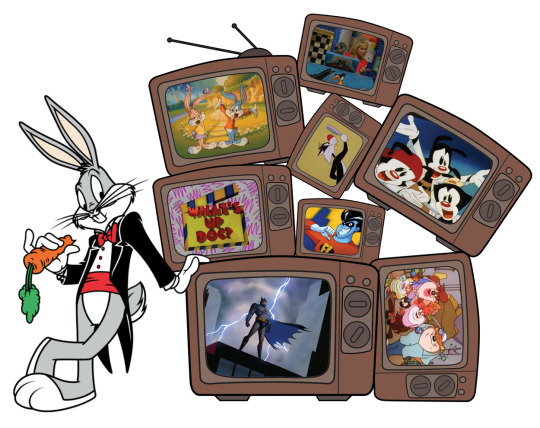
Having successfully wrangled the rights to Warner Brothers' library of Looney Tunes cartoons from their traditional home on Seven, Channel Nine had grand plans to celebrate the 50th anniversary of everyone's favourite wascally wabbit. Their initial attempt, aptly titled "The Bugs Bunny Show", was hosted by Sophie Lee and aired weekdays beginning on 4th June 1990. In spite of drawing strong ratings from kids and parents with heavy emphasis on Merrie Melodies shorts (and the occasional Real Ghostbusters, another show poached from Seven), it wasn't to last, with the final episode airing 7th February 1992.
But Nine weren't willing to give up just yet. They switched tactics and set out to challenge then-juggernaut Saturday Disney, kicking off "What's Up Doc" at 8:30am. With Danielle Fairclough as the first in a rotating roster of hosts, viewers saw the continuation of popular series including Tiny Toon Adventures and Beetlejuice, along with an extra helping of new shows such as (and certainly not limited to) Taz-Mania, Animaniacs, Free Willy, Freakazoid, Superman: The Animated Series, and Histeria.
Yet it was Batman: The Animated Series which truly broke the mould. Riding high on the unprecedented success of Tim Burton's live-action films, the show took everything popular from Bob Kane and Bill Finger's beloved Caped Crusader and elevated them to a new level. The action more intense, the heroes more nuanced, the villains more three dimensional. And they in turn went on to influence and inspire their comic counterparts. Airing in its original production order, the series launched that same day and ran an unbroken 65 weeks, swiftly spawning an expansive toyline and slew of matching merchandise.
From Sophie Lee to Lauren Phillips, Andy Sunderland and everyone in between, "What's Up Doc" cemented the Looney Tunes' home on Nine. Its popularity led to a return of weekday afternoon cartoons, and later spinoffs for the next generation of fans including "The Cool Room" And "Kids' WB", each with their own unique hosts and lineups of animated adventures. The relationship between network and studio remained a strong one for just shy of two decades until it all came crashing down; with Nine choosing not to renew their exclusive license, the final "Kids' WB", and Looney Tunes on Australian TV in general, walked into the sunset on 29th November 2019.
#Looney Tunes#Bugs Bunny#Batman#Tazmanian Devil#Freakazoid#Animaniacs#Sylvester the Cat#Tiny Toon Adventures#What's Up Doc?#Australia#Saturday Morning Cartoons#Channel 9#1993#The irony of using the Please Please Pleese Get a Life Foundation is far from lost
15 notes
·
View notes
Text

Gary Dauberman, James Wan’s Atomic Monster Tackling Live-Action ‘Gargoyles’ for Disney+
lmost 30 years after first appearing as an animated television series, Gargoyles is taking flight once more, this time in live-action.
Two major names in the creature feature business, Gary Dauberman and James Wan’s Atomic Monster banner, known for their collaborations on the hit Annabelle horror movies, have teamed up to remake the 1990s cartoon as a live-action series for Disney+.
Dauberman will write, executive produce and showrun the series with Atomic Monster, the company run by Wan and Michael Clear, joining the executive producing ranks. The project is described as being in early development at Disney Branded Television.
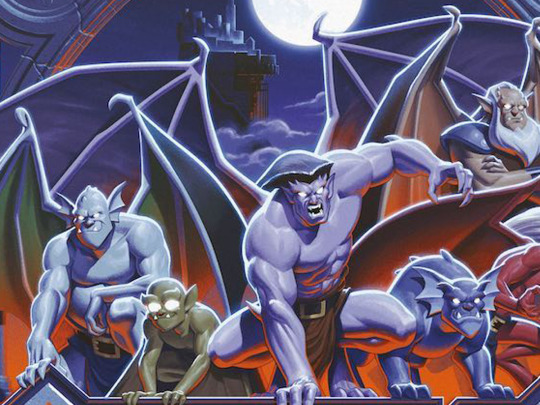
Gargoyles was made by Walt Disney Television Animation and aired three seasons, from 1994 to 1997. The premise involved gargoyle statues moved from a castle in Scotland to modern-day New York. Once in the Big Apple, the statues awaken from a thousand-year-old spell and take on the mantle of protecting the city, becoming, as the show’s narration gravely said, “stone by day, warriors by night.”
The series, created by Greg Weisman, came during a time of innovation in series animation, with Gargoyles riding a wave of shows with more complex storylines and darker tones that also included Batman: The Animated Series and X-Men. As with those shows, Gargoyles burrowed into the consciousness of a generation of TV watchers who have given it cult status.
#Gargoyles#James Wan#Atomic Monster#Walt Disney Television Animation#Disney Branded Television#Greg Weisman#Disney Plus#Gary Dauberman
6 notes
·
View notes
Text
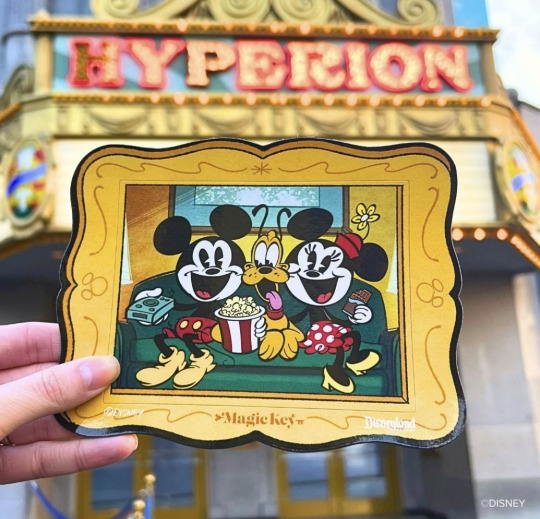
A brand new THE WONDERFUL WORLD OF MICKEY MOUSE magnet is set to debut later this month. Disneyland Resort Magic Key holders can enjoy a magnet exclusively at Disney California Adventure.
Desing is done by Asia Ellington (“The Wonderful World of Mickey Mouse” Franchise) & Paul Rudish (“The Wonderful World of Mickey Mouse” Franchise) with animation by Mercury Filmworks.
#The Wonderful World of Mickey Mouse#Wonderful World of Mickey Mouse#Mickey Mouse#Mickey Mouse 2013#Paul Rudish#Asia Ellington#Disneyland#Disney California Adventure#Disney Yellow Two Shoes#Walt Disney Imagineering#Disney Television Animation Rides#Disney TVA Rides
31 notes
·
View notes
Note
also there is a video that i think have two points about why anime is different from cartoons and might explain her obsession with western cartoons. the video/video series on YouTube J Lisle Writes is called "Cartoon's isn't Anime" that explains flaws better then any video that has Woke in it. 1 the Fan service is writing focused more then naughty fan-service (example there is a tendency for cartoons to take a cue from live action to make pop culture references, shipping and other stuff like that) 2 there is no variety to it, a lot of cartoons are still tied down to television and broadcasting groups that may limit what get shown with only Indie animation as an alternative to mainstream that could still get ride of it and suspiciously only have adult animation and live action series still standing when the Tax cut happens. 3 anime uses cinematography and arcs like in movies like Disney movies while cartoons are still stuck using old tools of comedy and having characters just standing around to save money like a lot of adult animation is guilty of doing and relying on writing more then animation. 4 the biggest problem with modern day cartoons is that its not because of "Woke" its because greedy rich people want money without building an audience and when you have a animation culture that has broadcasters that do not want to believe that a variety of animation types that they have in japan can and could happen here and maybe Indie Animation might be the first step.
what dose this have to do with LO? everything, her love for Adult animation and television shows that they are one and the same. they both have characters that stand around and make Pop Culture Reference's that are as cliched as a type of demographic love for the cliched Hallmark holiday movies. they are fundamentally the same which is probably why she has a lot of hatred for stuff that do not fit that kind of stuff as a joke a day type of series.
sorry I kind of don't make sense in the end of that. if there is some stuff I missed to add to this then tell me.
that video sounds very interesting and well researched, thank you!
17 notes
·
View notes
Text
Cars on the Road - Some Thoughts
Saw a bunch of people leaving their thoughts about the trailer sooo I figured I would do the same, I have some stuff that I want to discuss.

Easily the first thing that hit me about the series upon the drop of its trailer is the QUALITY. They outdid their first film with a television series, that is insane! They look fluid and smooth, their lighting and reflections are amazing, and they truly spare no detail in making every last one of these characters fluid and expressive. Pixar you animation gods, you’ve done it again. 13/10, I hope these animators did not hurt themselves trying to design this series.
Okay okay now I want to talk about the thing that had me most interested. Can we talk about the GHOST CARS please???

I will not lie to you, this section of these ghost cars coming to life, and dancing with McQueen in this big room is just, the coolest shit here, I am so psyched for this part of the series. And I’ve got so many questions! Is this Cars haunted mansion, are we going to see elements from the Haunted Mansion ride in Disney put onto this presumed hotel? How did all of these ghost cars come to haunt this place? How did they DIE?
Fanfic wise this could open up a whole new ballgame of things, such as Lightning trying to cope with seeing this after Doc’s passing (if any of you guys have the taste for some strong angst). And on the...*cough* less PG-13 rated side of the spectrum, car possession is now available to be played with as friskily as dared. I’ve already got friends screaming at me not to do it and I legit just might only for shits and giggles. XD
There’s a few things that kinda concern me, too, at least from what we see in the trailer. Here’s just what I’ve asked since I’ve watched it, uh like...like five times-
-Where are so many characters, including and not limited to Mack, Cruz, all the dudes from Rust-eze, all the other racers, and literally anyone from Cars 2??
-Why exactly are Lightning and Mater going on this road trip alone? Is Mack missing because he’s doing something else somewhere? Or Lightning decided that it was going to be a more relaxing and interesting trip if it wasn’t in a trailer the whole time? We know this is Mater’s trip mainly since he’s going to see his sister for her wedding but wouldn’t Lightning want to be the helpful friend and offer a faster ride if they needed it?
(also very important side note, I am so happy that this series is going to be a COMBO and not more Mater’s Tall Tales. Lightning is himself, and he’s being allowed to be kinda open and bubbly and excited to be on this trip with Mater as a team, not just him getting roped into every weird adventure by force and being confused about it. He has a natural desire to actually be here, which is great)
The depiction really reminds me of what they tried to do for Cars 2, but failed at slightly because of the fact that Lightning and Mater were doing separate things and sharing spotlight was getting difficult. But it’s also more than the occasional one-liners that they reduced Mater down to in Cars 3. I hope the balance of the trailer actually does play out into the series, and it’s consistent.
By the way, I combed and combed and combed and at NO POINT did it appear that there was any indicators of the Planes crew being nearby, which has me concerned and rattled. If they aren’t in there after they promised us they would be, I swear to Chrysler I’m gonna make it myself.
(By the way, friends and I are already screaming about the possibility of a season 2 and the chance that rather than going east, they could go west into northern California to an unspecified national park and run into a certain fire and rescue team *intensely waggling eyebrows* We need it so damn bad, Pixar PLEEEEEASE, adopt the late Disneytoon Studio’s orphaned children!!!)
Unorganized additional thoughts:
McQueen having a love of dinosaurs is the fucking cutest thing ever and you cannot tell me otherwise. I will be implementing this into future fics thank you vert much.
Is that monster truck just Cruz? I think that monster truck is just Cruz-
WHY do I have the feeling that the end of this road trip will be met with disaster? We’ve got a clear destination and I have a sinking feeling that when they get there it’s not going to be at all like it was planned.
Okay that’s all we have time for fans and freaks, take care my lovely weirdos, til the morrow, byeeeeee-
#Disney Cars#pixar cars#cars on the road#pixar cars on the road#disney planes#lightning mcqueen#mater
75 notes
·
View notes
Text
Disney World Parks in Orlando A Magical Family Adventure

Orlando, Florida, is synonymous with magical experiences, and at the heart of this enchanting city lies the crown jewel of family entertainment – Disney World Parks. Comprising four distinct theme parks, each with its own unique charm and attractions, a visit to Disney World is a dream come true for families seeking an unforgettable adventure. In this article, we will delve into the magic that awaits at Disney World Parks in Orlando and explore the wonders that make it the ultimate destination for a family getaway.
Magic Kingdom: Where Dreams Come True
The iconic Cinderella Castle welcomes visitors to the Magic Kingdom, setting the stage for a day filled with enchantment and wonder. Home to classic attractions such as Space Mountain, Pirates of the Caribbean, and the Haunted Mansion, Magic Kingdom captures the essence of Disney magic. Families can explore themed lands like Fantasyland, Tomorrowland, Adventureland, and Frontierland, each offering a unique blend of rides, shows, and character encounters.
Epcot: Journey into the Future and Around the World
Epcot, short for Experimental Prototype Community of Tomorrow, offers a distinctive experience with its focus on innovation, technology, and global culture. Divided into Future World and World Showcase, Epcot features attractions like Test Track and Spaceship Earth in Future World, while World Showcase takes visitors on a journey through 11 pavilions representing different countries. The annual Epcot International Food & Wine Festival adds an extra layer of excitement, enticing visitors with delectable global cuisines.
Disney's Hollywood Studios: Lights, Camera, Action!
Step into the glitz and glamour of the entertainment industry at Disney's Hollywood Studios. This park celebrates the magic of movies, television, and popular culture. Star Wars: Galaxy's Edge immerses guests in the Star Wars universe, while Toy Story Land brings beloved characters to life. Don't miss the thrilling rides like Rock 'n' Roller Coaster Starring Aerosmith and the Twilight Zone Tower of Terror. Hollywood Studios is a haven for film enthusiasts and those seeking an adrenaline rush.
Disney's Animal Kingdom: A Wild Expedition
For nature lovers and wildlife enthusiasts, Disney's Animal Kingdom is a paradise blending entertainment and conservation. The iconic Tree of Life stands tall in the center of the park, surrounded by attractions like Expedition Everest, Kilimanjaro Safaris, and Pandora – The World of Avatar. Immerse yourself in the beauty of the animal kingdom while enjoying thrilling rides and mesmerizing live shows that showcase the wonders of the natural world.
Park-Hopper Option: Unlimited Magic, One Ticket
To make the most of your Disney World adventure, consider the Park-Hopper option, allowing you to visit multiple parks on the same day. This flexibility enables families to customize their experience, hopping between the magic of Magic Kingdom, the innovation of Epcot, the excitement of Hollywood Studios, and the wildlife wonders of Animal Kingdom. With the Park-Hopper option, the enchantment knows no bounds.
Character Encounters: Meeting Your Favorite Disney Friends
One of the highlights of a visit to Disney World is the chance to meet beloved Disney characters. From Mickey and Minnie Mouse to Cinderella and Elsa, character encounters are scattered throughout the parks. Keep an eye out for scheduled meet-and-greet sessions, parades, and character dining experiences, creating magical moments for children and adults alike.
Dining at Disney: Culinary Delights for Every Palate
Disney World is not just a haven for attractions but also a culinary paradise. With a diverse range of dining options, from quick-service snacks to fine dining experiences, there's something to satisfy every palate. Be sure to explore the unique dining opportunities, including character dining experiences, themed restaurants, and international cuisine at Epcot's World Showcase.
Tips for a Magical Experience: From FastPasses to Parade Viewing
To ensure a seamless and enjoyable visit, consider these tips for navigating Disney World Parks. Utilize the FastPass system to skip the lines for popular attractions, plan your day with a personalized itinerary, and secure a good spot for parades and nighttime spectaculars. Additionally, staying on-site at a Disney resort can enhance your overall experience, providing convenient access to the parks and exclusive perks.
A trip to Disney World Parks in Orlando is more than a vacation; it's a magical journey that creates lasting memories for families. Whether you're soaring through the skies on Space Mountain, exploring the diverse cultures of World Showcase, or coming face-to-face with your favorite Disney characters, the enchantment of Disney World is unparalleled. Plan your adventure, embrace the magic, and embark on a family getaway filled with joy, wonder, and the promise that dreams really do come true in the heart of Orlando.
2 notes
·
View notes
Text

Squideo’s Favourites: Toy Story
Pixar Animation Studios arrived with a bang when its first feature-length film, Toy Story, was released in 1995. What would follow was a franchise beloved by children, spawning multiple spin-offs, theme park rides, video games and merchandise. Nominated for 4 Academy Awards, Toy Story is now considered one of the best animated films of all time.
Toy Story is credited with opening up the world of 3D computer animated films, which still rules the industry to this day. With the sponsorship of Disney, Pixar used this technology to create a film that visually stood apart from everything else at the box office and helped complete Pixar’s journey from a small computer division at Lucasfilm to an award-winning studio that has produced some of the best animated films of the past thirty years.
We’re diving into the production behind this animated film, exploring the style and techniques which came together to create this compelling story. In the meantime, if you have an idea for an animated video of your own get in touch with the Squideo team.
Creating a Story
To any fan of animation, Buzz Lightyear and Woody are well-known characters. Yet without Tinny, who reached nowhere near as much fame, they may never have graced our screens.
Pixar Animation Studios had produced a number of animated shorts before it ventured into feature length production, starting with Luxo Jr. (which introduced Pixar’s mascot). Red’s Dream followed, but it was Tin Toy that caught Disney’s attention. Financed by Steve Jobs, Tin Toy was a five-minute short created and directed by John Lasseter. Seen through the perspective of a toy running away from a destructive infant, Tin Toy laid down the groundwork for Toy Story – another Lasseter creation.
Disney had only recently allowed films to be made outside its own production company, starting with Tim Burton’s Nightmare Before Christmas (1993).
In a 2011 interview with Entertainment Weekly, [John Lasseter] said: "Disney kept trying to hire me back after each of the short films I had made. I kept saying, 'Let me make a film for you up here.” They always said, 'No, a Disney animated film will always be made at Disney.' They had no interest in doing an outside project." Lasseter continued: "What changed their mind was Tim Burton. Tim and I went to college together, and he had developed a feature idea called 'The Nightmare Before Christmas.' He went on to become a successful live-action director and was trying to buy 'Nightmare' back from Disney. And they said, 'Why don’t you just make it for us?' That opened the door for Disney to think of these niche animated films that could be done. They said, 'Okay, we’re willing to talk with you. We’ve got puppet animation going [with Tim Burton] and now we’ll be willing to develop the computer animation.' They said to come back when we had an idea. So we started thinking…" John Lasseter
youtube
3D computer animation developed alongside CGI in the 1970s, but a fully created computer animation television show or film didn’t debut until the 1990s. Yet animation companies, including Disney, had already played with the new technology before then. The Great Mouse Detective (1988) was the first Disney film to extensively use CGI: creating a two-minute sequence which was heavily promoted in the film’s marketing.
Their CGI was developed in cooperation with Pixar, the two companies coming together to make CAPS, the Computer Animation Production System which was relied upon heavily during the Disney Renaissance.
The technology was new, which put giant animation studios at a disadvantage. Their artists were trained in 2D animation techniques, leaving a void for computer companies who had the expertise to utilise this new technology.

Animation Style
The use of this new technology resulted in a film that looked vastly different from everything that predated it. Not only did 3D computer animation provide greater realism, but the independence of these early animators also meant they were not constrained by an existing “style” favoured by a company.
To this day, animated characters start life at Disney as 2D concept drawings which influences the style once it is converted to 3D. Pixar on the other hand is at home in that format, and their animators create greater complexities and detailed textures in their work.
“There are differences between Pixar and Disney. If you reduced Pixar to a phrase it would be: ‘Wouldn’t it be cool if?’ Like if a kid was looking at their toy: What if the toy could talk? All their films are like this. If you reduced the Disney films it would be: ‘Once upon a time…’.” Glen Keane
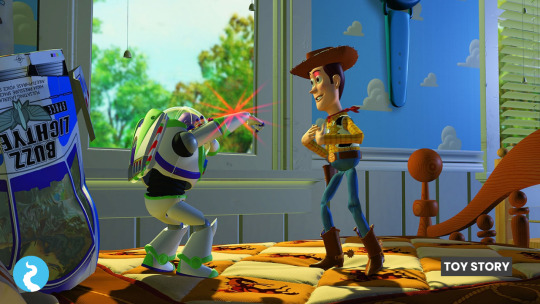
The filmmakers designed the minor characters using memories of their childhood toys, but the two leads were a different story. Woody and Buzz Lightyear went through several redesigns, along with the addition and removal of multiple human characters. Thankfully, Disney brought Joss Whedon onboard as a co-writer after reviewing the initial drafts. Now best known for directing and writing Marvel’s The Avengers (2012), Firefly (2002) and Buffy the Vampire Slayer (1997-2003), Toy Story was his first hit for which Whedon shared an Academy Award for Best Original Screenplay.
Because 3D computer animation was so new, even the lead actors didn’t know what the film would look like. Tom Hanks, who voiced Woody, said: “The shading and the light and its starting to look crisp and clean it looks surreal and real, it had a really neat 3-D quality to it without that fuzzy eyeball stuff.”
While Tim Allen, who voiced Buzz Lightyear, said: “When I first saw it I thought, 'I don't know if kids are gonna buy this, adults especially not, it's too high tech, it looks too much like a video game. And they got the second generation, third generation, it started looking slicker and slicker and then they finally finished with a shot of the soldiers going 'one, two, three, let's go!' and they went down the rope, wow! What a view!”
youtube
Pixar’s software was key to the animation of Toy Story. From RenderMan to Menv, the latter of which has since been replaced at Pixar by Presto, it took over 400 computer models to make the film. And it was worth every second of development. Toy Story showed the world that – not only was Pixar the new kid on the animation block – but that they also held the key to the future of animated film.
Get Started With Your Video
Inspired to create a unique animated video of your own? Watch the video below to get a better understanding of how Squideo can help promote your business, then get in touch with us to find out more!
youtube
#toy story#pixar animation studios#pixar#disney#walt disney animation studios#3d computer animation#3d animation#computer animation#buzz lightyear#woody#tin toy#tinny#steve jobs#john lasseter#tim burton#nightmare before christmas#CAPS#computer animation production system#glen keane#joss whedon#tom hanks#tim allen#renderman#menv#presto#youtube#2d animation#animation#small business on tumblr#small business
3 notes
·
View notes
Text

Each day is a blessing
It was my first time riding a ship that had air-conditioning and television with instructions, safety guidelines and playing different Disney movies that kept me entertained on the way to Bohol that took almost 2 hours and a half. When we arrived at the port there was a restriction on bringing any pork items in since there was recent flu on pork, luckily we did not bring any chicharon. We were welcomed by our tour guide and got in the van. I was excited to explore what amazing things there are in Bohol and there are amazing things indeed.
1st location


Our first location was this floating restaurant called Rio Verde at Tagbilaran road, Loan. They had an appetizing, delectable buffet that includes a variety of Filipino dishes and kakanin while also enjoying an acoustic guitar performance onboard. As we circled around the river for our meal, we felt the refreshing breeze of the coconut trees which was an added experience. There is also a stop in which there are people dancing and performing in tribal clothes and weapons that you can take a photo as a souvenir and leave a tip.

This place surely was a memorable place for me since I got to eat and definitely a must visit place for it is enjoyable and serene at the same time.
2nd location


And of course we had to see the tarsiers for ourselves, it wasn't as much fun as I thought since you have to remain silent as you follow the track provided. Although, you may take a picture with or the tarsiers itself but you have to make sure that there is no shutter sound or flash that would startle the tarsiers and freak out. They were photogenic and interesting at the same time. The staff will take a picture of you and the trasier closer to the camera which made them appear huge in the picture. It was a bit pricey and I can say not that worth it, but it's one of Bohol's treasures and I am lucky to see them.
3rd location


This forest hiding the roads from above is also a tourist spot and it's called Bilar man-made forest. We took the "buwis buhay shot" where you have to avoid passing vehicles while taking a picture in the middle of the road with the towering trees. No kidding!!! It got me real hyped up as I tried to be cautious, afraid of getting hit, but also mesmerized by the trees. In my perspective, it felt like I am in an anime movie.
4th location
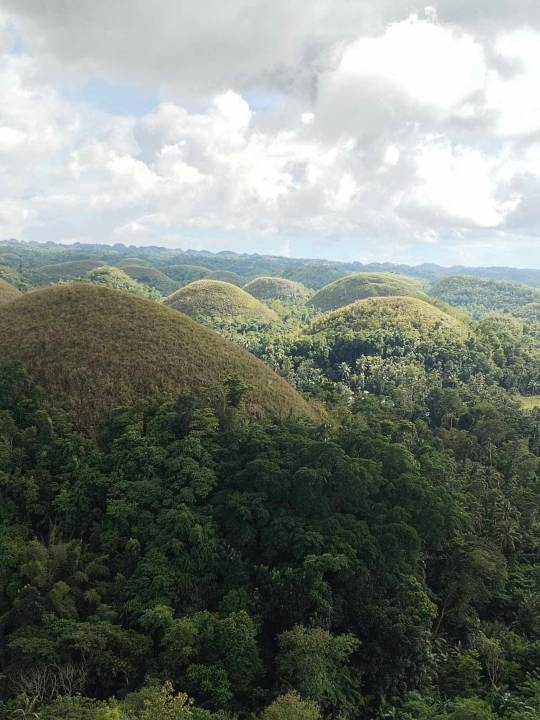
OMG, God made the Earth so beautiful that I could not take my eyes off of it. The jaw dropping view of the Majestic Chocolate Hills!!! We had to climb up countless steps of stairs to get the best view and when I say it is worth it, it really is, I felt like accomplishing an achievement that is priceless and felt like I had to explore more of these amazing landscapes and I felt thankful that I have existed in this life ever since I saw the Chocolate hills. It felt all magical that I literally got goosebumps and chills down my spine.
Next but not the least

Our warm down destination was a vibrant butterfly garden where they explained the types of butterflies, what they eat and made humorous jokes about them maintaining the butterflies. As you dive in deeper they also have snakes, interesting birds and a bear sort of type and of course each tourist spot has a souvenir shop
And all of that was possible in just one day, a day worth to enjoy yourself and make memories that surely are unforgettable and would make you want to go back with the right amount of budget. I cherished these moments as if it is a one in a lifetime opportunity since life is short but we can make lots of good deeds and memories.
2 notes
·
View notes
Text
ANIMATED LUCY!
Lucille Ball & Animation

Lucille Ball worked with many performers, and many of them were just as famous for their voices as their faces! As well as working for Desilu, actors worked for Warner Brothers, Disney, and other producers of animation - some of which is still popular today.
DISNEY
Walt Disney himself turned up on "Hedda Hopper's Hollywood" (1960), one of the gossip columnist's television specials that also featured Lucille Ball, among many others.
VERNA FELTON
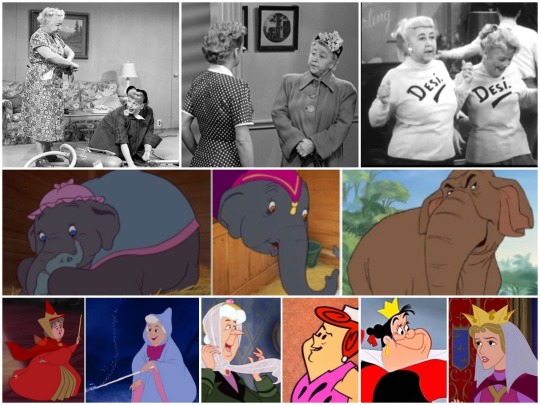
Verna Felton (1890-1966) made her professional stage debut at the age of 10 as ‘Little Verna Felton,’ working extensively on stage. On “I Love Lucy” Felton portrayed Mrs. Porter, the no-nonsense housekeeper in “Lucy Hires a Maid” (1953). and Mrs. Simpson in "Sales Resistance” (1953), a housewife to whom Lucy tries to sell a Handy Dandy vacuum cleaner - only to find out that she has no electricity! She received two Emmy nominations for her role in the Desilu series “December Bride,” playing Hilda Crocker from 1955 to 1959 opposite Spring Byington as Lily. In one episode, producer Desi Arnaz guest-starred as himself.
For Walt Disney, Felton voiced three elephants: Elephant Matriarch and Mrs. Jumbo in Dumbo (1941), as well as Winifred in The Jungle Book (1967). She played two Queens: The Queen of Hearts in Disney’s Alice in Wonderland (1951) and Queen Leah in Sleeping Beauty (1959). Her more human characters included Aunt Sarah in Lady and the Tramp (1955) and - a rare non-Disney female - Pearl Slaghoople, Wilma’s mother, on “The Flintstones”. She also voiced two wand-wavers: Flora in Sleeping Beauty and - perhaps most famously - The Fairy Godmother in Disney’s Cinderella (1950), where she introduced the song “Bibbidi-Bobbidi-Boo” to the world.

Her son, Lee Millar Jr., made four appearances on “I Love Lucy" and one episode of "The Lucy Show." He appeared with his mother in the 1955 animated feature Lady and the Tramp as Jim Dear and the Dogcatcher. Felton's husband and Millar's father, who did not appear with Lucy during his career, was most famous as the voice of Disney's Pluto from 1930 until his death in 1941.
ELEANOR AUDLEY

Eleanor Audley (1905-1991) played Lucille Ball’s mother-in-law on “My Favorite Husband.” She would later play Eleanor Spalding, owner of the Westport home the Ricardos buy in “Lucy Wants To Move to the Country” (1957) as well as one of the Garden Club judges in “Lucy Raises Tulips” (1957). She was seen as a Society Reporter on a 1965 episode of "The Lucy Show."
She is probably best known, however, as the voice of two of Disney’s most memorable animated villainesses: Lady Tremaine, the wicked stepmother in Cinderella (1950); and the evil Maleficent in Sleeping Beauty (1959). She served as the physical model for both characters.
HANS CONRIED

Hans Conried (1917-1982) first worked with Lucille Ball in the 1942 film The Big Street and played a myriad of roles on her radio show “My Favorite Husband.” On “I Love Lucy” he had just played Mr. Jenkins, used furniture salesman (above), a month earlier in "Redecorating" (1952) and returned to play Percy Livermore, "The English Tutor" (1952).
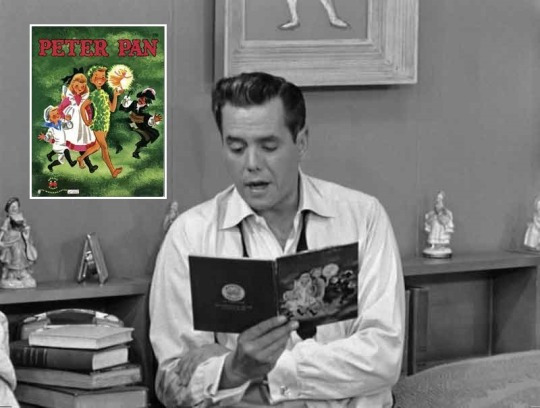
Early in the episode, Ricky reads from a children's book. While the story he reads is Little Red Riding Hood, the book cover is definitely Peter Pan. Coincidentally (or not), Conried had just finished voicing Captain Hook / Mr. Darling for Disney's animated feature Peter Pan, which would be released just a month later, in February 1953. That same year he voiced Thomas Jefferson in Disney's animated short, Ben and Me. Perhaps his best loved voice was that of Snidely Whiplash on the Bullwinkle and Dudley Do-Right cartoons starting in 1959. Conried made two appearances on "The Lucy Show" (both as acting / voice coach Dr. Gitterman) and on "Here's Lucy" with his long-time co-star Danny Thomas.
PINTO COLVIG

Pinto Colvig (1892-1967) was the original voice of Disney’s Pluto and Goofy. He provided the neighs for Gulliver the horse in "Horseback Riding" (1949), an episode of Lucille Ball's radio series "My Favorite Husband". He also did all the dog barks for “Lucy is Her Own Lawyer” (1964).
GINNY TYLER

Ginny Tyler (1925-2012) voiced Clementine the sheep in “Lucy Buys a Sheep” (1962), Greenback, Mr. Mooney's cockatiel, in "Lucy Gets the Bird" (1964), and Polly the Parrot in "Lucy in the Jungle" (1971). She also did the voices of the sheep in Disney’s Mary Poppins and the singing squirrel in The Sword in the Stone. She started out narrating record albums for Disney, including “Bambi” and “Babes in Toyland.”
JUNE FORAY

June Foray (1917-2017) was one of Hollywood's most famous and busiest voice actors. She did the voice of Lucifer the cat in Disney's Cinderella (1950), and voiced a mermaid and a squaw in Disney's Peter Pan (1953), among others. In 1957, she did the barks of Fred the dog on "I Love Lucy." She is probably best remembered as Rocky the Flying Squirrel and Natasha Fatale in the "Bullwinkle" cartoons.
CLEO
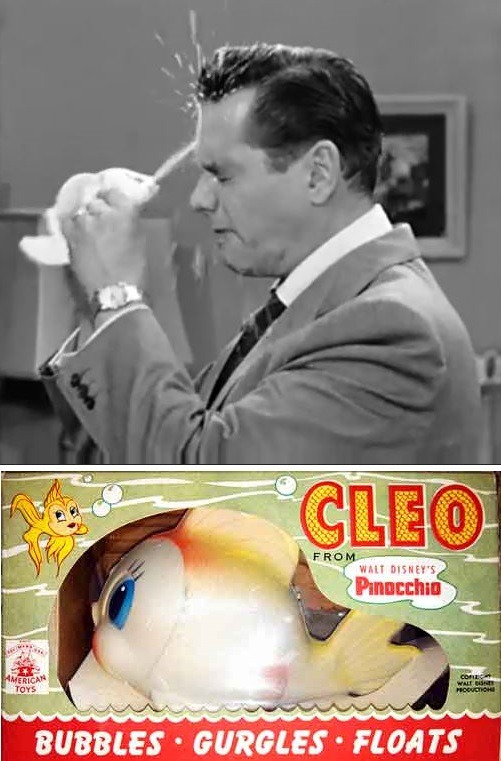
When "The Ricardos Change Apartments" (1953), Lucy fills the flat with as many toys as possible, including a bathtub toy called Cleo, the goldfish from the Disney Pinocchio (1940). When Ricky squeezes her, Cleo spits in his face!
SNOW WHITE AND THE SEVEN DWARFS

In 1938, Lucy modeled ladies' hats based on the characters Prince Charming and Sneezy from Disney’s Snow White and the Seven Dwarfs. Needless to say, she looked “charming”.
In a 1949 episode of "My Favorite Husband," Liz and Iris bemoan that they won't be going anywhere sunny for summer vacation. They say their goodbyes.
LIZ: “Goodbye, Paleface!”
IRIS: “See you later, Snow White!”
The Paleface was a Bob Hope / Jane Russell film released at the very end of 1948. Snow White and the Seven Dwarfs (1937) featured the voices of future “Lucy” cast members Pinto Colvig and Moroni Olsen.

"LUCY AND THE MONSTERS" (1965) involves a shared horror movie dream. To find out who is the prettiest witch, Lucy and Viv ask the magic mirror: “Mirror, mirror on the wall; Who’s the fairest of them all?” This is the same query the Evil Queen asks her magic mirror in the Disney film Snow White and the Seven Dwarves. In the film, the voice was that of Moroni Olsen, who played the Judge in the "I Love Lucy" episode "The Courtroom" (1952).
CINDERELLA

“Bibbidi-Bobbidi-Boo” a song written in 1948 by Al Hoffman, Mack David, and Jerry Livingston for the 1950 Disney animated film Cinderella, was heard in a 1950 episode of "My Favorite Husband" titled "Liz Writes a Song". For inspiration, George suggests they listen to the radio and hears "Bibbidi-Bobbidi-Boo”. Mr. Atterbury (Gale Gordon) questions what the nonsense lyrics mean.
In "CHER...AND OTHER FANTASIES" (1979) a Cleaning Lady (Lucille Ball) pushes a cart and sings “Bibbidi-Bobbidi-Boo,” Cher just wants to get out of the building. The Cleaning Lady suggests she wait till midnight when her white mice and pumpkin turn into a coach and horses. The special also includes a reference to....
BAMBI

Winding her way through the warehouse, Cher encounters Shelley Winters, a purveyor of movie memorabilia.
CHER: “Do you have 'Bambi’?”
SHELLEY: “I don’t have that in stock, but I’ve got a rifle from 'Winchester 73.'”
Winchester 73 was a 1950 film about a prized rifle that starred Shelley Winters and James Stewart. Shelley fires the rifle in the air and Cher takes on the roles of Bambi’s mother and father.
DUMBO

"Liz and the Green Wig" (1950), an episode of "My Favorite Husband" includes a mention of Dumbo, Disney's 1941 animated film about a flying circus elephant.
KATIE: “Well, maybe he’s forgotten.”
LIZ: “Not George. He has the memory of an elephant.”
GEORGE (from the other room): “Liz, is that you? Come on in the breakfast room.”
LIZ: “There’s Dumbo now.”
In a 1948 episode of the radio sitcom, Sarah Selby played Louise Elliott, Liz’s Mother. Selby made her screen debut voicing Prissy the Elephant in Dumbo.
DONALD DUCK
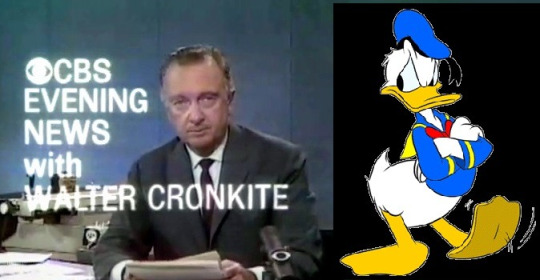
"LUCY, THE DISC JOCKEY" (1965) Mr. Mooney deems any voice contest between him and Lucy like comparing Walter Cronkite to Donald Duck, one of Walt Disney’s most enduring cartoon creations. He first appeared in 1934 and his squawking raspy voice was provided by Clarence Nash.
Other "Lucy" performers who voiced Disney animated characters:
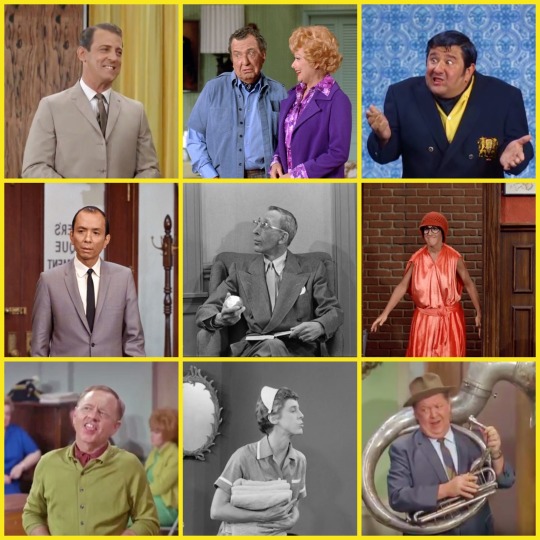
Paul Winchell (Winnie the Pooh / The Aristocats / The Fox and the Hound)
Phil Harris (The Jungle Book / The Aristocats / Robin Hood)
Buddy Hackett (The Little Mermaid)
James Hong (Mulan)
Charles Lane (The Aristocats)
Ruth Buzzi (The Aristocats)
Mickey Rooney (The Fox and the Hound)
Nancy Kulp (The Aristocats)
Hal Smith (several roles)
Joseph Kearns (Alice in Wonderland)
Norma Zimmer (Alice in Wonderland)
WARNER BROTHERS & OTHERS
ARTHUR Q. BRYAN ~ ELMER FUDD
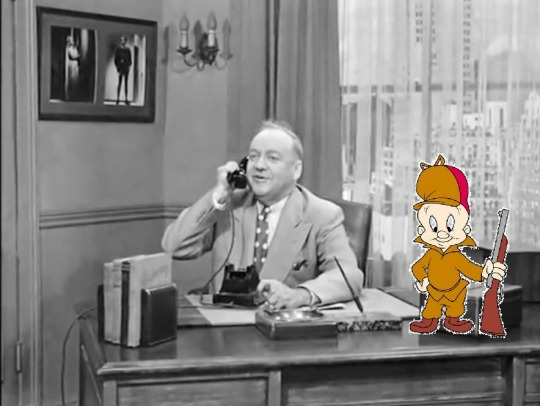
Arthur Q. Bryan (1899-1959) had appeared with Lucille Ball in Look Who's Laughing (1941). He is best remembered as the original voice of Elmer Fudd in the Warner Brothers cartoons. He played Mr. Chambers, new owner of the Tropicana, in "Ricky Loses His Voice" (1952).

"MOTHER OF THE BRIDE" (1986) ~ The final episode of Lucille Ball's final sitcom, "Life With Lucy."
LUCY: "When Margo was little she found my dress in the attic and she called it 'the most bootiful dwess in the world'! When she was little she talked a lot like Elmer Fudd.”
MEL BLANC ~ BUGS BUNNY / PORKY PIG
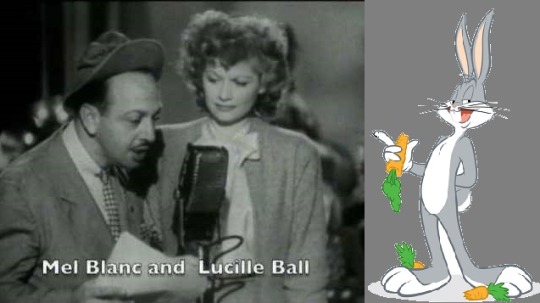
One of the most famous voices in show business belonged to Mel Blanc, who was most famous for voicing Bugs Bunny. Lucy worked with Blanc in her 1950 film The Fuller Brush Girl portraying a parrot. Blanc and Ball had also teamed for an Armed Services Radio broadcast in 1944.

"LUCY GETS AMNESIA" (1964) involves a rabbit fur coat, causing Viv to say "What's up, Doc?", which was Bugs Bunny's famous tag line. Lucy's last line of the episode also mentions Bugs Bunny.
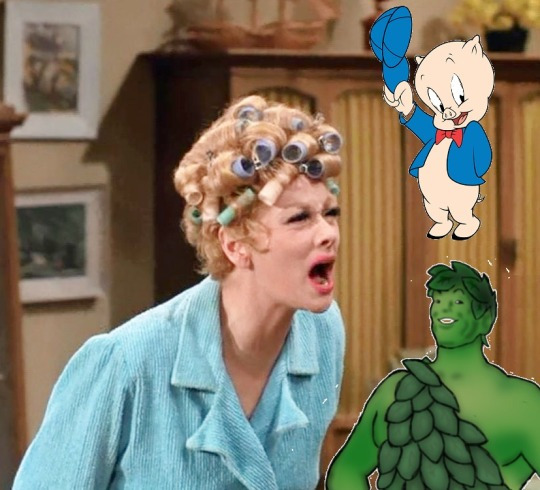
"LUCY AND TENNESSEE ERNIE'S FUN FARM" (1969) Doing a commercial for the farm, Lucy plays a slovenly housewife who calls her husband Porky Pig and the Jolly Green Giant.

In 1969, Mel Blanc did ADR (automatic dialogue replacement) for two characters on location footage in "LUCY GOES TO THE AIR FORCED ACADEMY: PART 2".

Elvia Allman, who made multiple appearances on "I Love Lucy" and "The Lucy Show", did the voices of several cartoon characters for Warner Brothers, most notably Little Red Riding Hood.
In 1960, Blanc joined Alan Reed, Bea Benadaret and Jean Vander Pyl (all of whom had worked with Lucille Ball) as Barney Rubble in TV's first animated sitcom Hanna Barbera's...
"THE FLINTSTONES"

Although ostensibly modeled on "The Honeymooners," "The Flintstones" owed a great debt to Lucille Ball. Many of the Bedrock storylines were borrowed from Lucycoms. Wilma Flintstone bore more than a passing resemblance to the famous redhead. Others who acted live with Lucy that loaned their voices to prehistoric characters: Janet Waldo, Harvey Korman, Howard Morris, Hal Smith, Verna Felton, June Foray, Howard McNear, Herb Vigran, Sandra Gould, Jerry Hausner, Paul Winchell, and many others.
"THE JETSONS"
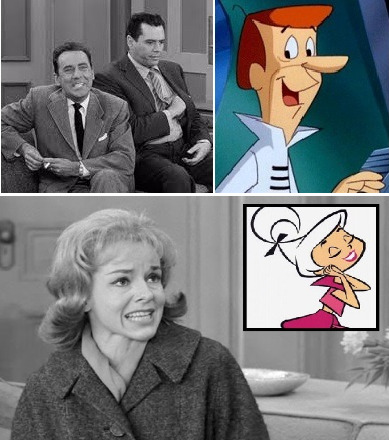
In the wake of the success of "The Flintstones", Hanna Barbera rocketing to the other end of the spectrum - from caves to space - with "The Jetsons"(1962). Leading the cast as Dad George Jetson was George O'Hanlon, who had played Charley Appleby on "I Love Lucy." His daughter Judy was played by Janet Waldo, who played Peggy Dawson on "I Love Lucy" and Lucy's sister Marge on "The Lucy Show". Jean Vander Pyl and Mel Blanc turned up as Mr. and Mrs. Spacely.
"TOP CAT"

Allen Jenkins appeared with Lucille Ball in the film Five Came Back. He then did three episodes of "I Love Lucy," all as policemen. It was natural that his animation legacy was as Officer Dibble on the Hanna-Barbera TV cartoon, “Top Cat” (1961–62). Other Lucy alumni who appeared frequently on the show included Jean Vander Pyl, Bea Benadaret, Hal Smith, Gege Pearson, and Herb Vigran.

Select episodes of Lucille Ball's radio sitcom "My Favorite Husband" have been computer animated and are available to view on Vimeo. They were animated by Wayne Wilson using the soundtracks of the original broadcasts.
In “Lucy and the Soap Opera” (1965), soap actor Mr. Vernon (John Gregory) brags his daytime drama role of Roger Gregory is the best part he’s played since doing the voice Oink-Oink in the [fictional] “Piggy Pete” cartoons! Lucy says she’d like to say Richard Burton go from playing “a pig in a poke to a teller in a bank.”

Oh, and don't forget "The Simpsons"! Lucille Ball has had several representations on the long-running show, including as Oyster Shell Lucy, a handicraft sold by Moe in “Homer’s Barber Shop Quartet” (1993).
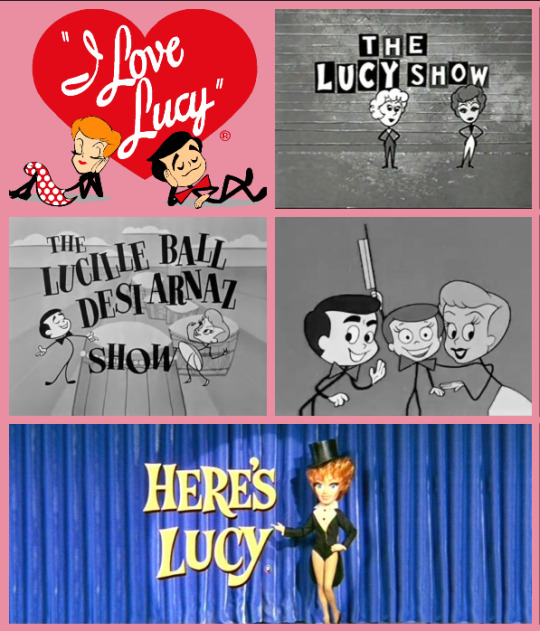
Lastly, Lucy herself was an animated character. The original opening credits and commercial intros for "I Love Lucy" featured stick-figure animation of Lucy and Desi. The tradition continued during "The Lucy-Desi Comedy Hours", adding Little Ricky. "The Lucy Show" also opened with stick figure animation, but it only lasted for one season. "Here's Lucy" took animation to the next level, with a stop-motion doll of Lucy presenting the opening credits.
#animation#disney#warner brothers#Lucille ball#I Love Lucy#Here's Lucy#The Lucy Show#My Favorite Husband#cartoons#Top Cat#The Jetsons#The Flintstones#Mel Blanc#Arthur Q Bryan#Porky Pig#Elmer Fudd#Buggs Bunny#TV#Snow White#Cinderella#Pinocchio#Donald Duck#Dumbo#Cher#Shelley Winters#June Foray#Pinto Colvig#Ginny Tyler#Mary Poppins#Hans Conried
4 notes
·
View notes